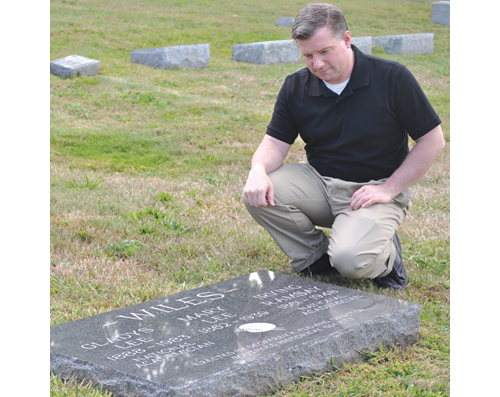Memory of famed artists preserved with headstone

In a remote Cutchogue cemetery, about four miles from the center of Southold Town, lies the grave of famed 1920s impressionist artist Irving Ramsay Wiles. But until recently, no one would ever know that.
The cemetery, marked only by two stone pillars and is set back from Route 25, is easy to overlook. Mr. Wiles, a once-wealthy Peconic painter, died penniless and was buried without fanfare in an unmarked grave, as his heirs were unable to afford a headstone.
It remained that way for 65 years. His artwork seemingly lost to time.
That was, until Southold Historical Society director Geoffrey Fleming came across documents that brought his legacy to life.
The historical society received hundreds of documents that were rescued from Mr. Wiles’ former residence on Indian Neck Road before it was demolished in the 1980s. The papers included letters and notes detailing the family’s relationships and reflections.
Inspired by the writings, Mr. Fleming went on to publish three books about the Wiles family.
His research eventually revealed Mr. Wiles’ unceremonious burial in 1948 alongside his wife, May. When his daughter, Gladys Lee Wiles, also a well-known painter, died in 1983 she was buried next to her father but, Mr. Fleming said, her grave was also unmarked due to a lack of funds.
Seeing a need to remember the family, Mr. Fleming saved and then spent several thousand dollars of his own money to design and erect a permanent marker over these graves, which would likely have otherwise been forgotten about forever.
“It just seemed ridiculous that these two prominent artists were buried in an unmarked grave here on the North Fork,” Mr. Fleming said. “Artists as good as Irving and Gladys Wiles were very deserving of having a proper monument, and I am happy to have been able to rectify the situation.”
Mr. Wiles was known nationally for his work, particularly portraits and landscapes. Today, his paintings hang in major collections across the country, including the Smithsonian American Art Museum in Washington, D.C., and the Metropolitan Museum of Art in New York City.
Both Mr. Wiles and his daughter were members of the National Academy in New York City, one of the nation’s most prominent artist-based organizations.
On the stone, installed in April, both Irving and Gladys Wiles are noted as being “National Academicians,” a distinction bestowed by members of the National Academy on artists they believe are among the best in the nation.
The Wiles family began visiting Peconic in the 1880s and built a summer home there in the late 1890s. During the Great Depression Mr. Wiles, who was accustomed to spending lavishly, was forced to sell his property and reside on the North Fork. Members of the family remained in Peconic until Gladys’s death in 1983. There are no living relatives, Mr. Fleming said.
The Wiles family included at two other painters, Irving’s parents, Lemuel and Rachel Wiles. But Irving became the family’s most famous member.
Mr. Fleming said his next project will be to get enough money together to erect a monument to Lemuel and Rachel Wiles, who are buried in an unmarked plot in a cemetery in Patterson, N.J.
“There is always another worthy project,” he said.








